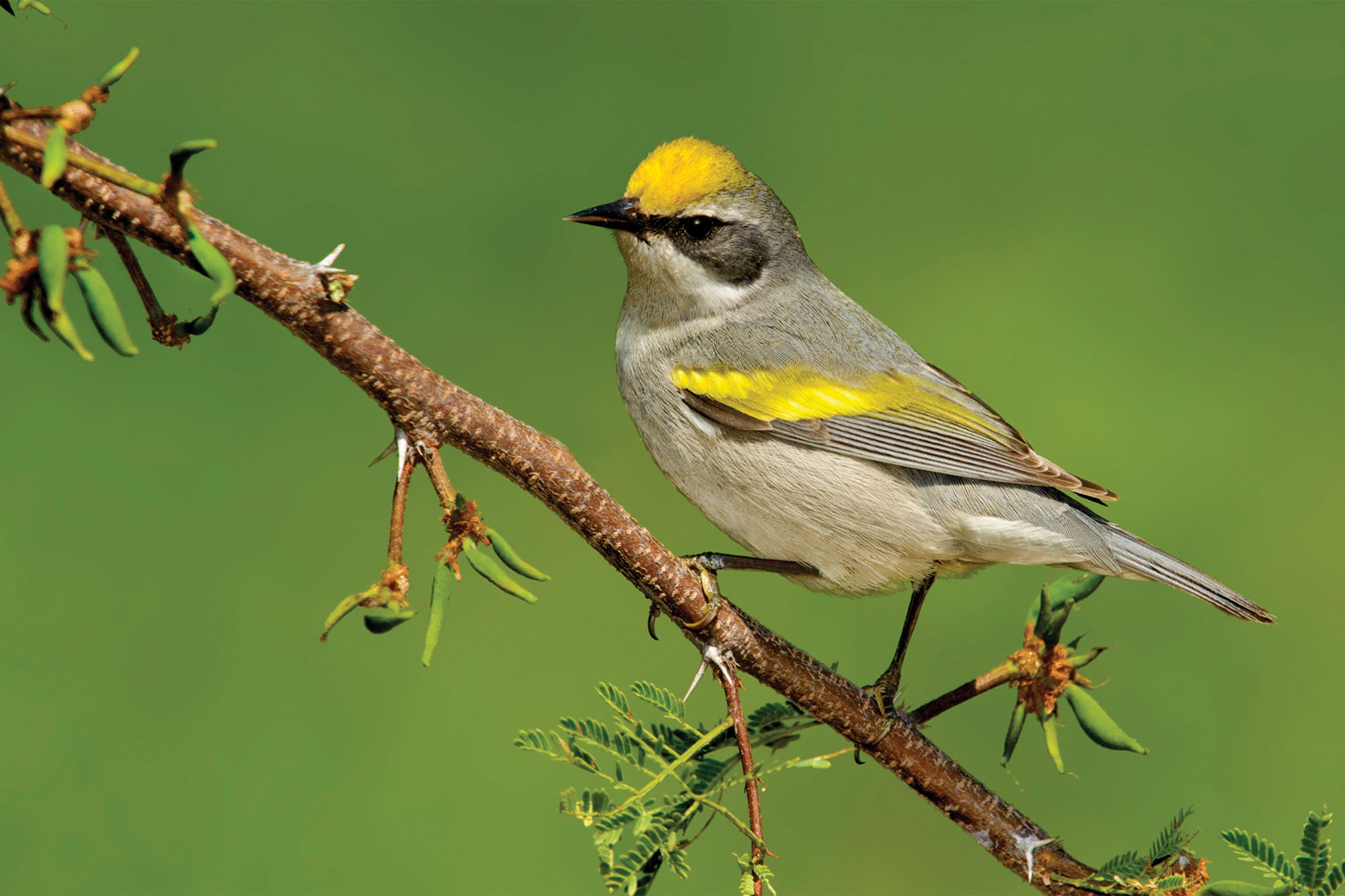In Indiana, yellow birds are a common sight during the spring and summer seasons when the warblers make their arrival. However, in the winter, the American Goldfinch is the most frequently seen yellow bird in the area.
To assist you in identifying the yellow birds you spot in Indiana, this guide provides pictures, identification details, song recordings, and migration patterns.
The majority of yellow birds in Indiana are warblers, orioles, or tanagers, and sometimes the females of these species look significantly different from the males.
With the comprehensive information provided in this guide, identifying yellow birds will become much easier. The list of yellow birds is arranged according to their frequency of sightings in Indiana during spring and summer (May and June), based on eBird checklists.
Yellow birds found in Indiana throughout the year include the American Goldfinch.
Yellow birds found in Indiana during the summer months include the Common Yellowthroat, Baltimore Oriole, Cedar Waxwing, Yellow Warbler, Eastern Meadowlark, American Redstart, White-eyed Vireo, Scarlet Tanager, Yellow-throated Warbler, Yellow-throated Vireo, Orchard Oriole, Dickcissel, Prothonotary Warbler, Summer Tanager, Prairie Warbler, Hooded Warbler, Western Meadowlark, and Yellow-headed Blackbird.
Yellow birds found in Indiana during migration include the Yellow-rumped Warbler, Palm Warbler, Black-throated Green Warbler, Nashville Warbler, Magnolia Warbler, Blue-winged Warbler, Pine Warbler, Cape May Warbler, Wilson’s Warbler, Canada Warbler, Orange-crowned Warbler, and Evening Grosbeak.
Accidental yellow bird sightings in Indiana include the Western Kingbird, Western Tanager, Painted Bunting, and Audubon’s Oriole.
So, continue reading to successfully identify the yellow birds you have spotted.
A Compilation of 31 Yellow Birds in Indiana:
1. American Goldfinch
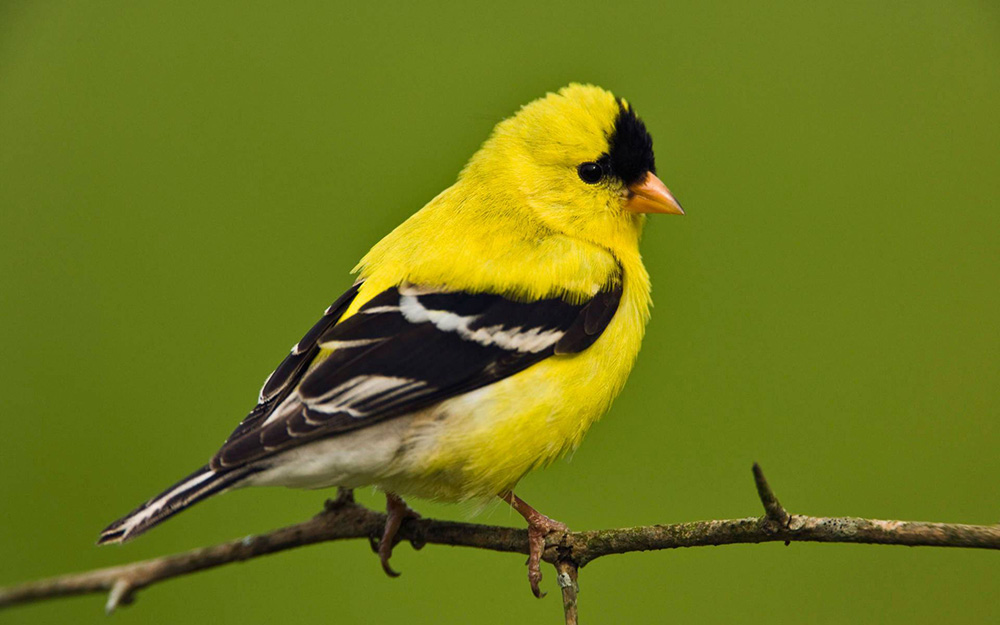
Throughout the year, the American Goldfinch can be found in Indiana. It is observed in 46% of checklists during the summer and 32% during the winter, according to reports submitted by birdwatchers in the state.
The American Goldfinch is a popular bird, especially during spring when the males display their vibrant yellow and black plumage. In comparison, the females are less colorful, with a duller brown appearance, especially during the winter months.
Scientific name: Spinus tristis
Length: 4.3-5.1 inches (11-13 cm)
Weight: 0.4-0.7 ounces (11-20 g)
Wingspan: 7.5-8.7 inches (19-22 cm)
American Goldfinches can be found in various parts of North America and are typically present year-round. However, those that breed in Canada and the Midwest migrate to southern US states for the winter.
These birds can be seen foraging for sunflower, thistle, and aster plants in weedy fields, overgrown areas, suburbs, parks, and backyards.
American Goldfinch Song:
American Goldfinches typically build nests in shrubs using rootlets and woven plant material, secured to branches with spider webs. They lay up to seven eggs, which hatch after approximately two weeks. The young remain in the nest for two to two and a half weeks before fledging.
To attract American Goldfinches to your backyard, consider planting thistles and milkweed. They readily visit most bird feeders and prefer sunflower and nyjer seeds.
Fun Fact: Due to their exclusively vegetarian diet, American Goldfinches refuse to raise young cowbirds, leading to the chicks’ demise within a few days.
2. Common Yellowthroat
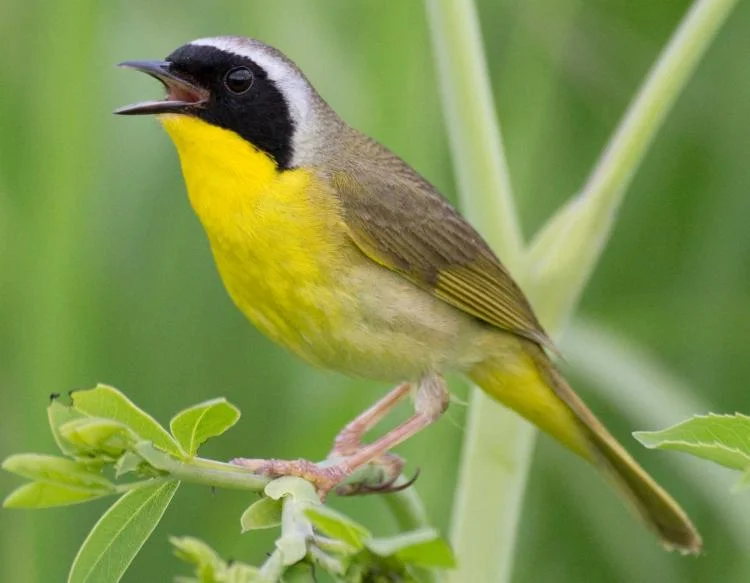
During the breeding season in Indiana, the Common Yellowthroat is frequently observed. These birds are primarily seen from April to October and appear in 31% of summer checklists.
Common Yellowthroats are small songbirds with brownish backs and vibrant yellow undersides. The males have distinctive black masks across their faces. The brightness of their yellow plumage may vary geographically, and the females often exhibit a more olive appearance on their undersides.
Scientific name: Geothlypis trichas
Length: 4.3-5.1 inches (11-13 cm)
Weight: 0.3-0.3 ounces (9-10 g)
Wingspan: 5.9-7.5 inches (15-19 cm)
During the summer, Common Yellowthroats breed across most of North America, excluding Alaska and northern Canada. Some individuals remain along the Gulf Coast and in the Pacific Southwest throughout the year, while others migrate south for the winter.
These birds can be found in marshy or wetland areas and brushy fields, often hiding within dense, tangled vegetation.
Common Yellowthroat Song:
Nests of Common Yellowthroats are typically built by females near the ground in marshy areas, using reeds for support. The nests are constructed with grass, sedges, and leafy materials, forming a cup-shaped structure. They lay up to six eggs, which hatch after approximately twelve days. The young leave the nest within a similar timeframe.
To attract Common Yellowthroats to larger backyards, provide dense vegetation and native plants that attract insects.
Fun Fact: Common Yellowthroats use the presence of a black mask to distinguish between courting males, displaying aggression towards fake birds without masks but not reacting to birds lacking a mask.
3. Yellow-rumped Warbler
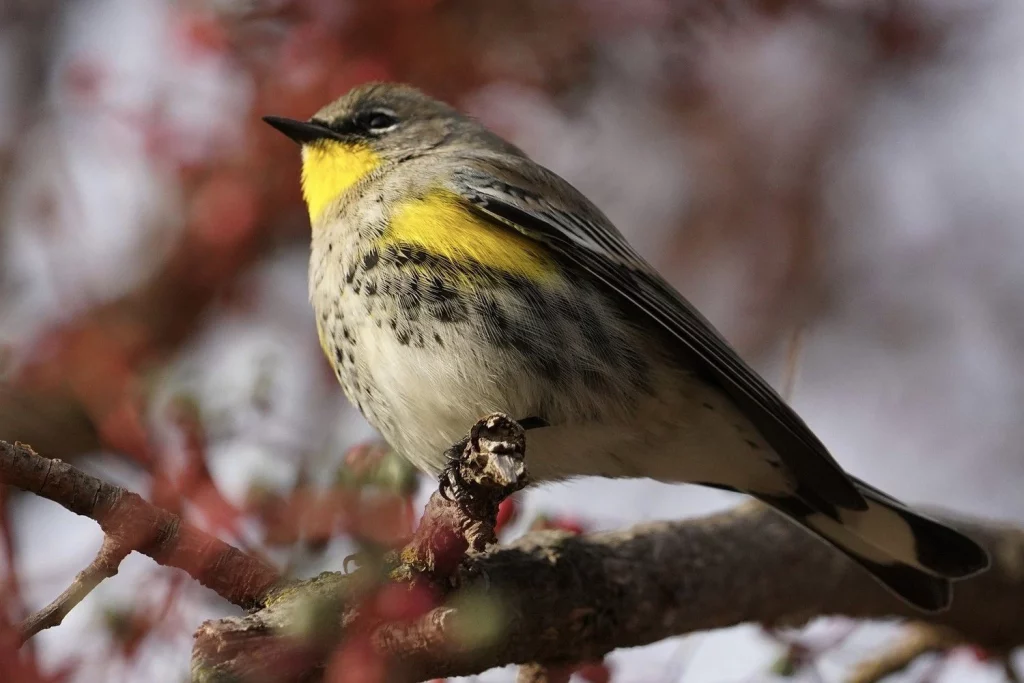
Yellow-rumped Warblers spend the winter in Indiana, with their numbers increasing during migration in April to May and September to November. These birds are reported in 2% of winter checklists and up to 39% of checklists during migration.
Yellow-rumped Warblers have predominantly gray plumage with flashes of yellow on their faces, sides, and rump. They also possess white wing patches. Females may exhibit a slight brownish coloration, while winter birds appear paler brown with bright yellow rumps and sides that transition back to gray in spring.
Scientific name: Setophaga coronata
Length: 4.7-5.5 inches (12-14 cm)
Weight: 0.4-0.5 ounces (12-13 g)
Wingspan: 7.5-9.1 inches (19-23 cm)
Yellow-rumped Warblers primarily breed in Canada, the Rockies, and the Appalachian Mountains. During migration, they can be observed in the Midwest before overwintering in southern and southwestern US states, along the Pacific Coast, and in Mexico and Central America.
These warblers can be found in coniferous forests, particularly during the breeding season, and in open areas with fruiting shrubs during winter. Their diet consists mostly of insects during the summer and fruit, including bayberry and wax myrtle, during migration and winter.
Yellow-rumped Warbler Song:
Nests of Yellow-rumped Warblers are constructed by females in conifer trees, utilizing twigs, pine needles, grass, and soft materials like moss and hair. The eggs, typically numbering six, hatch after approximately two weeks, and the young leave the nest within two additional weeks.
To attract Yellow-rumped Warblers to your backyard, offer sunflower seeds, suet, raisins, and peanut butter. Additionally, consider planting fruiting shrubs and trees.
Fun Fact: During winter, Yellow-rumped Warblers form large flocks numbering in the thousands and can exhibit aggression towards other species that encroach upon their territory.
4. Female Baltimore Oriole
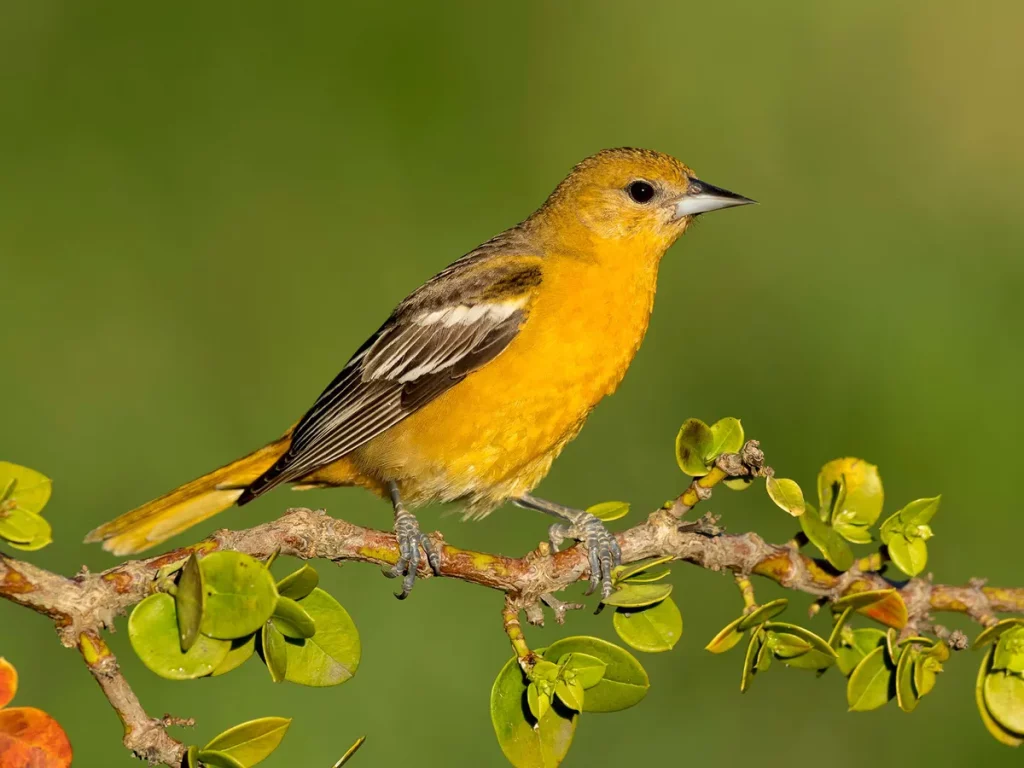
During the breeding season in Indiana, the Baltimore Oriole is the third most frequently observed yellow bird. These birds are primarily seen from April to September and appear in 27% of summer checklists.
Baltimore Orioles are colorful heralds of spring in the eastern region of North America. Adult males boast bright orange and black plumage with white wing bars on their black wings.
Females exhibit yellowish undersides and heads, along with grayish-brown wings and brownish-yellow backs. They are approximately the same size as Robins but possess a more slender physique, belonging to the blackbird family.
Scientific name: Icterus galbula
Length: 6.7-7.5 inches (17-19 cm)
Weight: 1.1-1.4 ounces (30-40 g)
Wingspan: 9.1-11.8 inches (23-30 cm)
Baltimore Orioles breed in Eastern and Central states, including central-southern Canadian provinces and areas along the southern US border. For the winter, they migrate to Florida, Central America, and the Caribbean, beginning their departure as early as July.
These birds can be found in open woodlands, along riverbanks, and at forest edges, where they forage for insects and fruit. They are known to visit parks and backyard areas as well.
Baltimore Oriole sounds: The flute-like song of the Baltimore Oriole is a delightful springtime experience. They also produce chattering and sharp alarm calls.
Attract Baltimore Orioles to your backyard by offering halved oranges on a platform feeder or hanging them from trees. Oriole feeders filled with sugar water can also be enticing. Planting fruiting trees and nectar-rich plants such as raspberries, crab apples, and trumpet vines is another effective method.
Fun Fact: Baltimore Orioles construct remarkable hanging nests woven from various fibers.
5. Cedar Waxwing
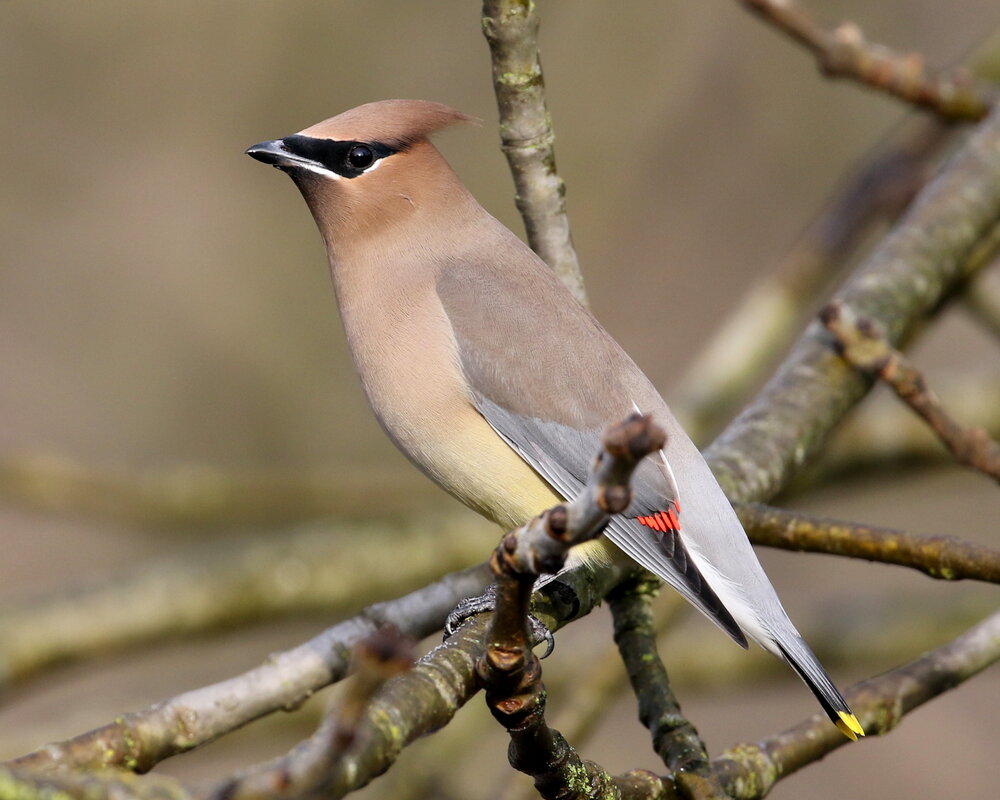
Cedar Waxwings are predominantly observed in Indiana during the summer, from May to November, and are recorded in 13% of checklists during this period. However, some individuals remain in the area throughout the year.
Cedar Waxwings are elegant and social birds with pale brown heads, chests, and crests that transition to gray on their backs and wings. Their bellies exhibit a pale yellow hue, and the tips of their wings display bright yellow accents. They possess narrow black masks across their eyes and bright red tips on their wings.
Scientific name: Bombycilla cedrorum
Length: 5.5-6.7 inches (14-17 cm)
Weight: 1.1 ounce (32 g)
Wingspan: 8.7-11.8 inches (22-30 cm)
Cedar Waxwings breed in Canada before migrating to the southern US, Mexico, and Central America for winter. They remain resident in northern US states throughout the year.
These birds can be found in berry bushes, woodlands, grasslands, towns, and along streams. They primarily feed on fruit, but during the summer, they also consume insects.
Cedar Waxwing Call:
Nests of Cedar Waxwings are constructed in trees using twigs, grass, hair, and plant material. The nests are lined with pine needles and soft grass. They lay up to six eggs, which hatch after approximately twelve days. The young leave the nest within sixteen days or so.
To attract Cedar Waxwings to your backyard,
consider planting native trees and shrubs that bear small fruits, such as serviceberry, dogwood, juniper, winterberry, and hawthorn. Additionally, providing fruit on platform feeders can be enticing.
Fun Fact: Cedar Waxwings exchange gifts while courting potential mates, passing items between them.
6. Yellow Warbler
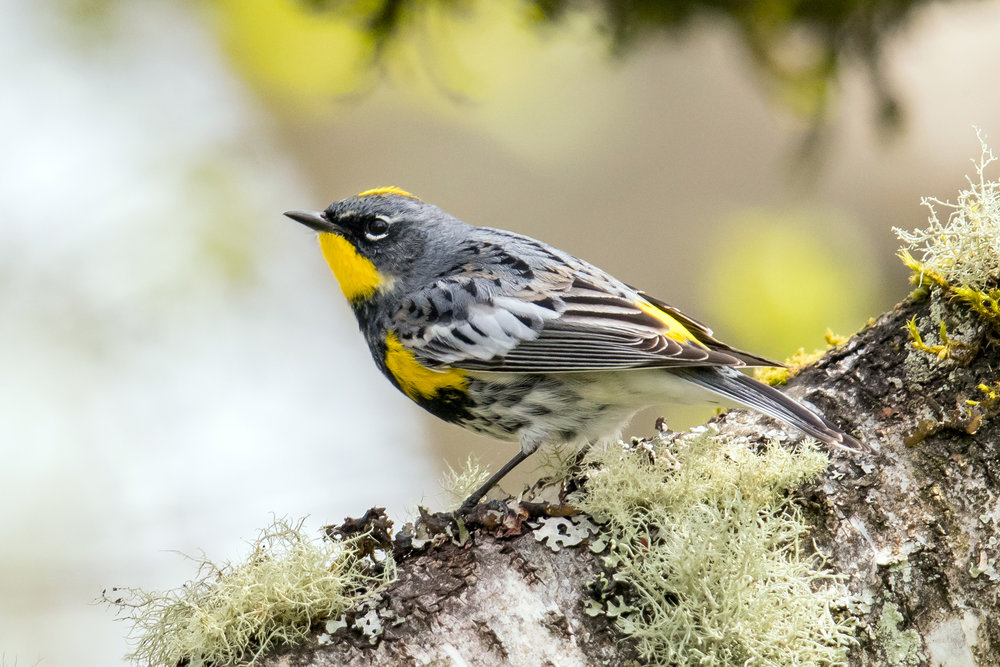
Yellow Warblers breed in Indiana and are observed from April to October. They appear in 24% of summer checklists.
Yellow Warblers are small, brightly colored birds with yellow-green backs. The males display chestnut streaks on their breasts, while the females and juveniles exhibit less vibrant plumage than the males.
Scientific name: Setophaga petechia
Length: 4.7-5.1 inches (12-13 cm)
Weight: 0.3-0.4 ounces (9-11 g)
Wingspan: 6.3-7.9 inches (16-20 cm)
Yellow Warblers migrate long distances to breed in Canada and the US, excluding southeastern states. They subsequently journey back to Central and South America for winter. However, they can be observed during migration in southeastern US states.
These warblers can be found along streams, wetlands, thickets, and field edges, where they forage for insects like caterpillars, midges, beetles, bugs, and wasps.
Yellow Warbler Song:
Nests of Yellow Warblers are typically built in small trees or shrubs, consisting of bark, grass, and woven plant material secured with spiders’ webs. The nests are lined with softer materials such as hair, feathers, and plant down. They lay up to seven eggs, which hatch after approximately twelve days. The young leave the nest within ten days.
To attract Yellow Warblers to your backyard, offer suet, oranges, peanut butter, and plants that bear berries. Additionally, planting native species that attract insects, while avoiding pesticides and excessive tidiness, can be beneficial. Installing birdbaths with fountains near secluded foliage provides additional protection.
Fun Fact: When Yellow Warblers detect cowbird eggs in their nests, they construct new nests on top of the old ones, up to six times, to ensure their own offspring’s survival.
7. Eastern Meadowlark
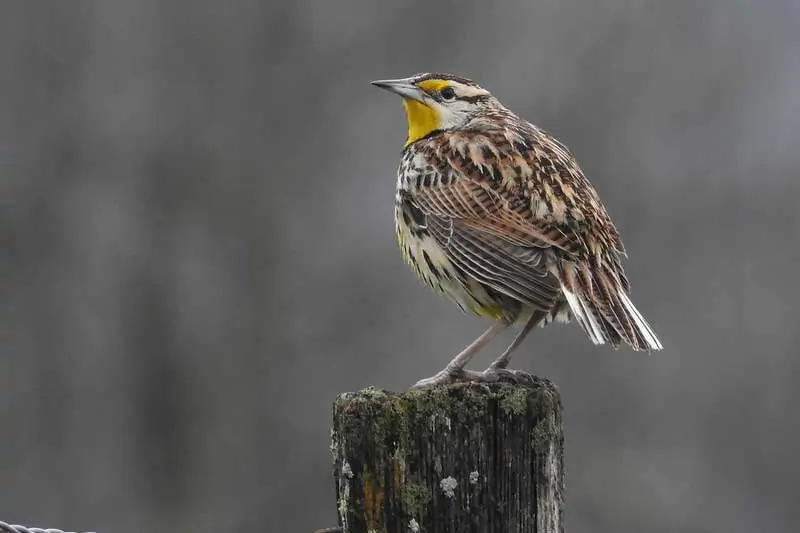
Eastern Meadowlarks, classified as near-threatened, are predominantly observed during the breeding season in Indiana and appear in 11% of summer checklists. However, some individuals remain in the area throughout the year.
Eastern Meadowlarks are medium-sized songbirds with bright yellow undersides and pale brown bodies adorned with black marks. They boast a distinct black band across their chests.
Scientific name: Sturnella magna
Length: 7.5-10.2 inches (19-26 cm)
Weight: 3.2-5.3 ounces (90-150 g)
Wingspan: 13.8-15.8 inches (35-40 cm)
Eastern Meadowlarks can be found year-round across eastern US states, while also breeding in the Northeast and Canada before migrating south.
Their melodic singing and displays mark the arrival of spring in the East. Unfortunately, they are now classified as a near-threatened species.
These birds can be found on the ground in grasslands and prairies, feeding primarily on insects. They gather in large flocks in fields during winter, searching for seeds.
Eastern Meadowlark sounds: They produce clear and melodious flute-like whistles.
Nests of Eastern Meadowlarks are situated on the ground and can feature remarkable constructions with tunnels and woven grass roofs.
Fun Fact: Eastern Meadowlarks are capable of singing more than 100 songs.
8. Female American Redstart

American Redstarts spend the breeding season in Indiana and are more commonly observed during migration in May and September. They appear in 10% of summer checklists and up to 27% of checklists during migration.
Male American Redstarts sport predominantly black plumage with vibrant orange patches and a white belly. Females, on the other hand, exhibit an olive-gray coloration instead of black, adorned with numerous yellow patches.
Scientific name: Setophaga ruticilla
Length: 4.3-5.1 inches (11-13 cm)
Weight: 0.2-0.3 ounces (6-9 g)
Wingspan: 6.3-7.5 inches (16-19 cm)
American Redstarts breed in eastern US states, Canada, and northwestern US states. During migration, they may also be observed in central and western US states.
These birds can be found in deciduous woodlands, where they feed on insects. They may also frequent backyards and thickets, particularly during their wintering period, and consume berries such as serviceberry and magnolia.
American Redstart song: The song of the American Redstart features a drop in pitch at the end.
Nests of American Redstarts are typically located close to tree trunks in trees or large shrubs. They are constructed using bark, grass, and plant materials. The eggs, numbering up to five, hatch after approximately two weeks, and the young leave the nest within a week or two.
To attract American Redstarts to your backyard, offer berry plants such as magnolia and serviceberry.
Fun Fact: Male and female American Redstarts both sing during winter, but only the males produce songs during spring and summer, continuously serenading from dawn until lunchtime.
9. White-eyed Vireo

Identification of the White-eyed Vireo
White-eyed Vireos spend the breeding season in Indiana and are primarily observed from April to October. They appear in 10% of summer checklists.
White-eyed Vireos feature gray heads with yellow tones around their foreheads and distinctive white eyes. They possess white throats and chests, yellow sides, greenish backs with darker wings, and two white wingbars.
Scientific name: Vireo griseus
Length: 4.3-5.1 inches (11-13 cm)
Weight: 0.3-0.5 ounces (10-14 g)
Wingspan: 6.7 inches (17 cm)
During the summer, White-eyed Vireos can be found across the southeastern United States, often hiding within thickets. Some individuals residing near the coast remain in the area year-round. They migrate to the southeast coast of Mexico and the Caribbean for winter.
These birds frequent overgrown pastures, brambles, and similar habitats, where they feed on insects, flies, and spiders. They also consume berries during winter.
White-eyed Vireo song:
Nests of White-eyed Vireos hang from branches in shrubs, initially formed using spiders’ webs and comprising leaves, bark, and plant materials. The interior is lined with soft grass, pine needles, and other gentle materials. They lay around four eggs, which hatch after two weeks, and the young leave the nest within approximately sixteen days.
Fun Fact: White-eyed Vireos sing throughout winter, but only the males produce songs during spring and summer, ceasing their melodious performances by lunchtime.
10. Scarlet Tanager Female
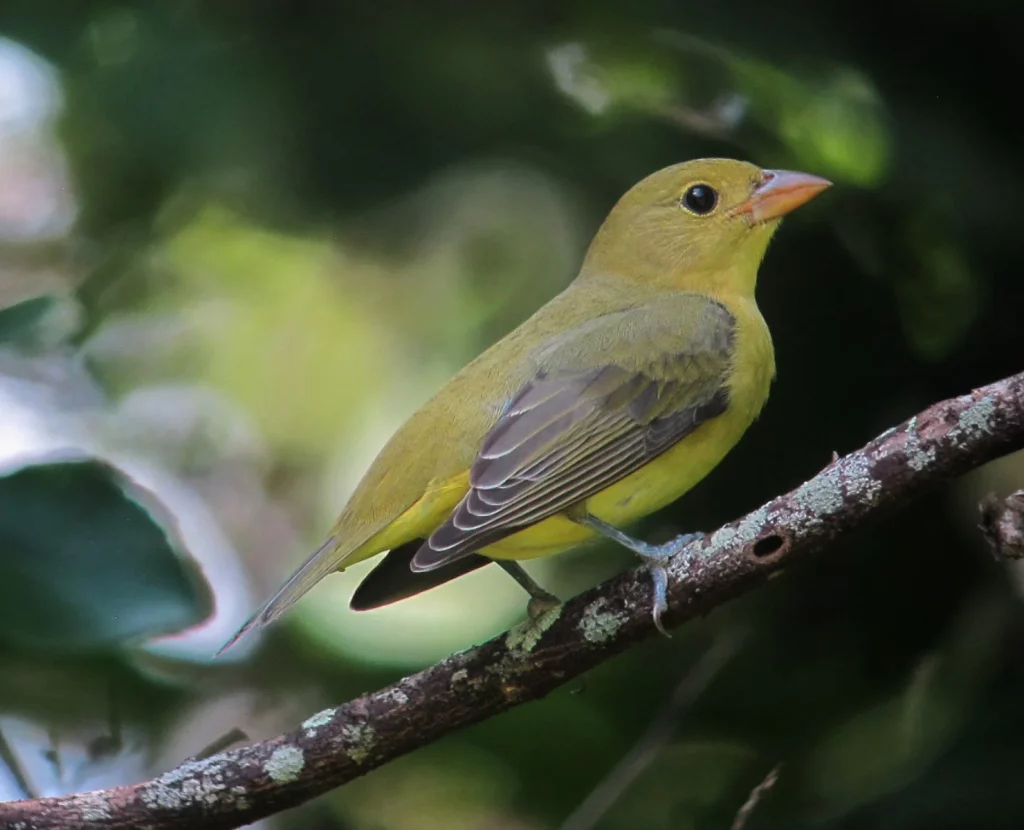
Identification of the Female Scarlet Tanager
Scarlet Tanagers spend the summer in Indiana and are observed from April to October. They appear in 10% of checklists during the summer season.
Female Scarlet
Tanagers exhibit yellow plumage with darker wings and tails, similar to molting males.
Male Scarlet Tanagers are striking birds with bright red plumage, black wings and tails, thick bills, and short tails.
Scientific name: Piranga olivacea
Length: 6.3-6.7 inches (16-17 cm)
Weight: 0.8-1.3 ounces (23-38 g)
Wingspan: 9.8-11.4 inches (25-29 cm)
During summer, Scarlet Tanagers breed in eastern forests before migrating to western South America. They can be observed in southeastern US states during their migratory journeys.
These birds tend to stay high in the forest canopy, making them challenging to spot. However, glimpses of their vibrant red plumage may be seen as they traverse branches in search of insects.
Scarlet Tanager Song:
Nests of Scarlet Tanagers are constructed by females in approximately four days, using loosely woven twigs, grass, and plant materials. The interiors are lined with soft grass, pine needles, and other gentle materials. They lay around four eggs, which hatch after two weeks. The young take approximately two weeks to fledge.
To attract Scarlet Tanagers to your backyard, consider planting berry-producing plants such as blackberries, raspberries, huckleberries, juneberries, serviceberries, mulberries, strawberries, and chokeberries.
Fun Fact: Male Scarlet Tanagers engage in singing battles, occasionally escalating into actual physical confrontations.
11. Yellow-throated Warbler
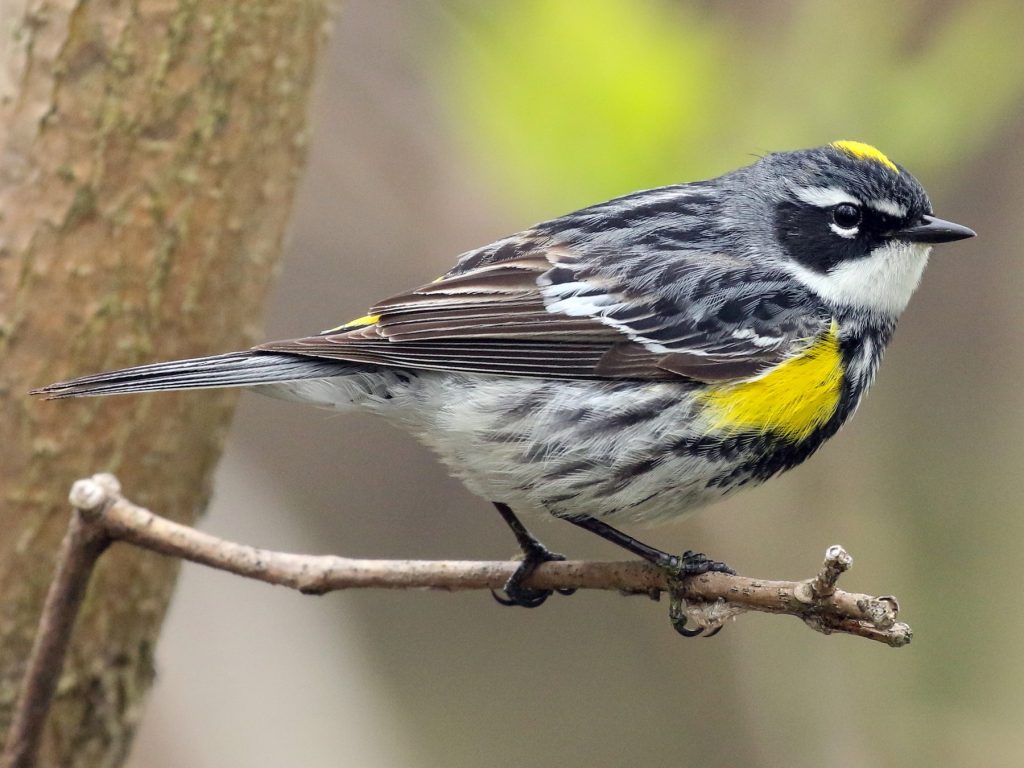
The Yellow-throated Warbler can be found in Indiana during the breeding season, from April to September. It is recorded in 9% of summer checklists.
Yellow-throated Warblers are small songbirds with yellow plumage on their throat, chest, and belly, contrasting with their black and white striped heads. They have gray backs and wings with white wing bars.
Scientific name: Setophaga dominica
Length: 4.7-5.1 inches (12-13 cm)
Weight: 0.3-0.4 ounces (9-11 g)
Wingspan: 6.7-7.5 inches (17-19 cm)
Breeding populations of Yellow-throated Warblers can be found in the southeastern and eastern United States. They migrate to Mexico and Central America for the winter.
These warblers inhabit swampy forests, wooded streams, and river bottoms, where they forage for insects, spiders, and small fruits.
Yellow-throated Warbler Song:
Nests of Yellow-throated Warblers are built by females, usually on a horizontal tree branch, using bark strips, twigs, leaves, and moss. They lay 3-5 eggs, which hatch after about 12 days. The young birds leave the nest within 10-12 days.
To attract Yellow-throated Warblers to your backyard, provide a variety of insects and caterpillars, as well as shrubs and trees that produce small fruits.
Fun Fact: Male Yellow-throated Warblers defend their nesting territories vigorously and may even attack larger birds that venture too close.
12. Yellow-throated Vireo

May 14th, 2015
Newton Hills State Park, South Dakota
The Yellow-throated Vireo can be observed in Indiana during the breeding season, from April to September, appearing in 8% of summer checklists.
Yellow-throated Vireos are small songbirds with olive-green upperparts and a yellow throat and breast. They have a distinct white eyering.
Scientific name: Vireo flavifrons
Length: 5.1-5.9 inches (13-15 cm)
Weight: 0.4-0.5 ounces (11-14 g)
Wingspan: 8.3-9.4 inches (21-24 cm)
Breeding populations of Yellow-throated Vireos can be found in the eastern United States and southern Canada. They migrate to Mexico and Central America for the winter.
These vireos inhabit deciduous forests and wooded areas near water, where they feed on insects, spiders, and small fruits.
Yellow-throated Vireo Song:
Nests of Yellow-throated Vireos are built by females in the forks of tree branches, using bark, grass, and other plant materials. They lay 3-5 eggs, which hatch after about 12 days. The young birds leave the nest within 10-14 days.
To attract Yellow-throated Vireos to your backyard, provide a variety of insects, small fruits, and dense vegetation for nesting.
Fun Fact: Yellow-throated Vireos often perform acrobatic maneuvers while foraging, hanging upside down and peering under leaves to find prey.
13. Orchard Oriole
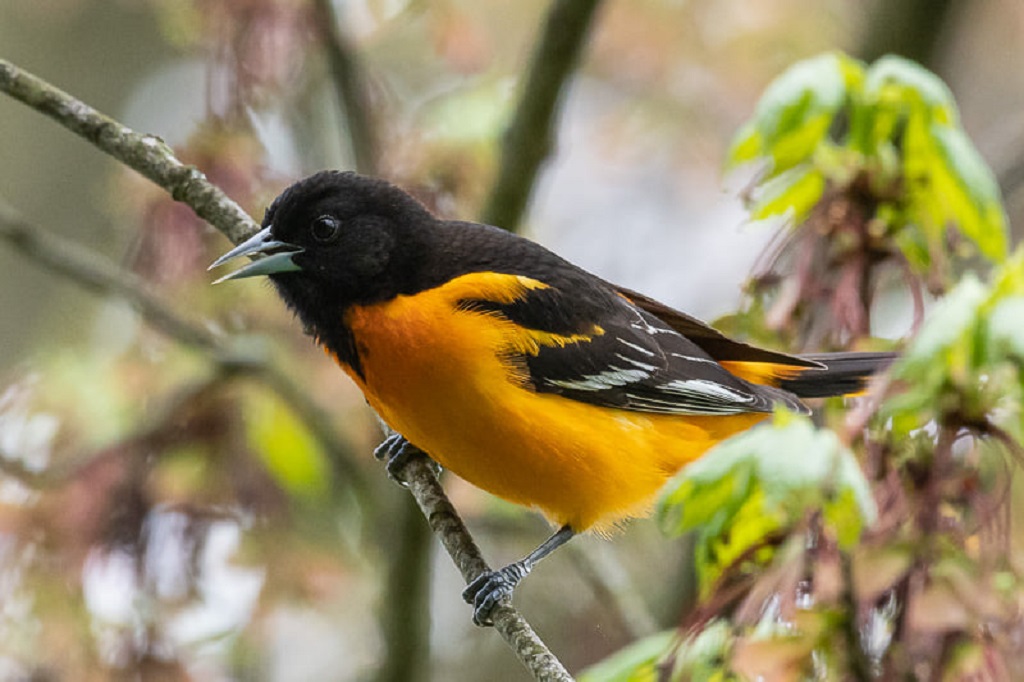
Orchard Orioles can be spotted in Indiana during the breeding season, from April to September, and are recorded in 8% of summer checklists.
Male Orchard Orioles have a striking appearance, with a chestnut body, black head and throat, and yellowish-green wings. Females are olive-brown with yellowish underparts.
Scientific name: Icterus spurius
Length: 5.9-6.3 inches (15-16 cm)
Weight: 0.6-0.8 ounces (17-23 g)
Wingspan: 8.7-10.2 inches (22-26 cm)
Breeding populations of Orchard Orioles can be found in the eastern and central United States. They migrate to Mexico and Central America for the winter.
These orioles inhabit open woodlands, orchards, and forest edges, where they feed on insects, nectar, and ripe fruits.
Orchard Oriole Song:
Nests of Orchard Orioles are intricately woven pouches made of grass, plant fibers, and hair. They are usually suspended from the outer branches of trees. They lay 3-6 eggs, which hatch after about 12 days. The young birds leave the nest within 10-12 days.
To attract Orchard Orioles to your backyard, provide fruit feeders, sugar water, and plant trees or shrubs that produce small fruits and flowers.
Fun Fact: Orchard Orioles are known for their unique nest-building behavior, often constructing nests close to wasp nests to deter predators.
14. Dickcissel

July 25th, 2008
Minnehaha County, South Dakota
Canon 40D, 400 5.6L
Dickcissels can be found in Indiana during the breeding season, from May to September, and appear in 7% of summer checklists.
Male Dickcissels have a distinctive black bib on a yellowish breast, with brown upperparts. Females are more subdued, with streaked brown plumage.
Scientific name: Spiza americana
Length: 5.5-6.3 inches (14-16 cm)
Weight: 0.7-1.1 ounces (19-31 g)
Wingspan: 9.8-11 inches (25-28 cm)
Breeding populations of Dickcissels can be found in the central and eastern United States. They migrate to southern Mexico and Central America for the winter.
These birds inhabit grasslands, prairies, and agricultural fields, where they feed on seeds, insects, and grasshoppers.
Dickcissel Song:
Nests of Dickcissels are built on the ground, often concealed in tall grass. They are cup-shaped structures made of grass and plant fibers. They lay 3-5 eggs, which hatch after about 10-12 days. The young birds leave the nest within 8-10 days.
To attract Dickcissels to your backyard, provide open grassy areas with seeds and insects as food sources.
Fun Fact: The name “Dickcissel” comes from the bird’s distinctive song, which resembles the sound of “dick-dick-ciss-ciss-ciss.”
15. Prothonotary Warbler
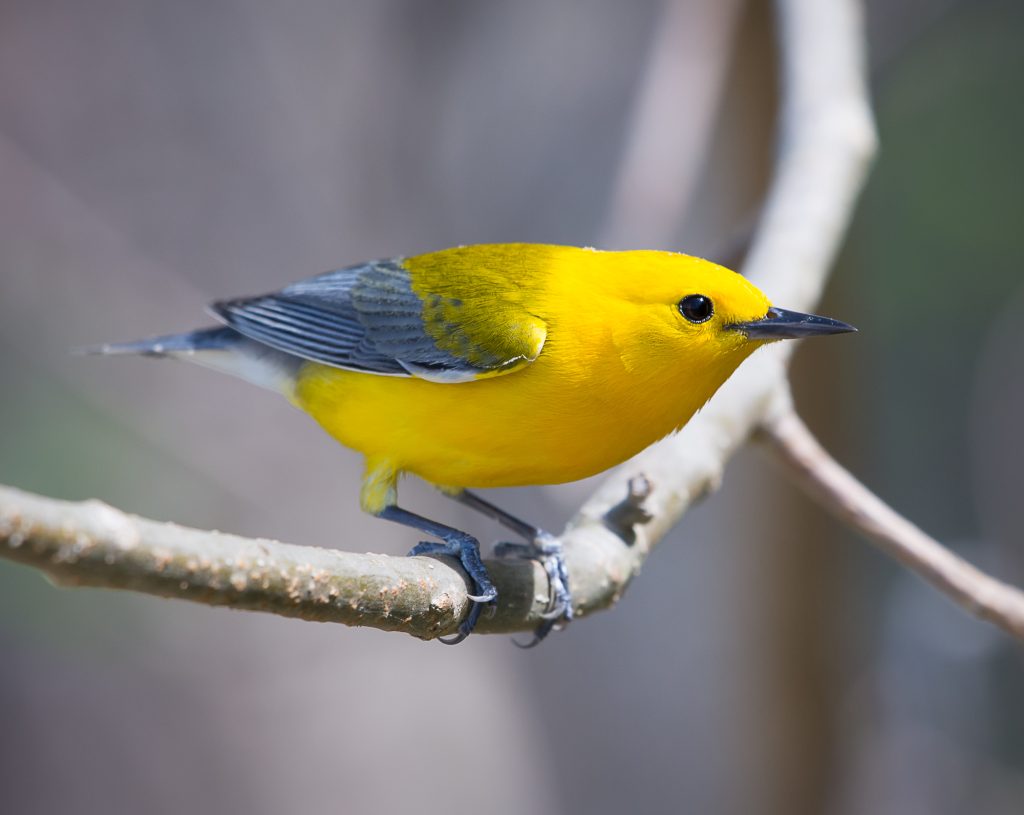
Prothonotary Warblers can be spotted in Indiana during the breeding season, from April to September, and are recorded in 7% of summer checklists.
Prothonotary Warblers are small songbirds with vibrant golden-yellow plumage, contrasting with their dark wings and tail. They have a slightly curved bill.
Scientific name: Protonotaria citrea
Length: 4.3-5.1 inches (11-13 cm)
Weight: 0.3-0.4 ounces (9-11 g)
Wingspan: 6.3-7.5 inches (16-19 cm)
Breeding populations of Prothonotary Warblers can be found in the southeastern United States and parts of the Midwest. They migrate to Central America and northern South America for the winter.
These warblers inhabit swampy forests, wetlands, and wooded streams, where they forage for insects and spiders.
Prothonotary Warbler Song:
Nests of Prothonotary Warblers are built in tree cavities or nest boxes, usually near water. They are made of moss, leaves, and bark, lined with feathers. They lay 3-7 eggs, which hatch after about 12-14 days. The young birds leave the nest within 9-12 days.
To attract Prothonotary Warblers to your backyard, provide nest boxes near water sources and maintain suitable wetland or wooded habitats.
Fun Fact: Prothonotary Warblers are the only eastern warbler species that nests in tree cavities, rather than building an open cup nest.
16. Summer Tanager
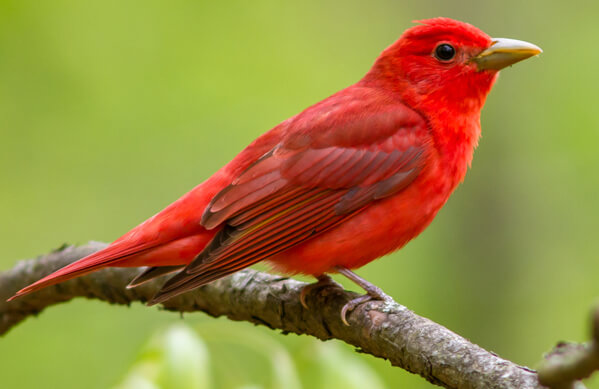
Summer Tanagers spend the breeding season in Indiana, from May to September, and are recorded in 7% of summer checklists.
Male Summer Tanagers are striking birds with entirely red plumage, while females exhibit a yellow-green coloration.
Scientific name: Piranga rubra
Length: 7.1-7.9 inches (18-20 cm)
Weight: 1-1.1 ounces (28-31 g)
Wingspan: 9.8-11.4 inches (25-29 cm)
Breeding populations of Summer Tanagers can be found in the southeastern United States and parts of the Midwest. They migrate to Mexico and Central America for the winter.
These tanagers inhabit open woodlands, forest edges, and parks, where they feed on insects, bees, wasps, and fruits.
Summer Tanager Song:
Nests of Summer Tanagers are usually located in the outer branches of trees, constructed using twigs, grass, and plant fibers. They lay 2-5 eggs, which hatch after about 12-14 days. The young birds leave the nest within 10-12 days.
To attract Summer Tanagers to your backyard, provide a variety of insects, especially bees and wasps, as well as fruit feeders.
Fun Fact: Male Summer Tanagers can sometimes be found engaging in a behavior called “anting,” where they rub ants on their feathers to obtain formic acid, which may help repel parasites.
17. Prairie Warbler
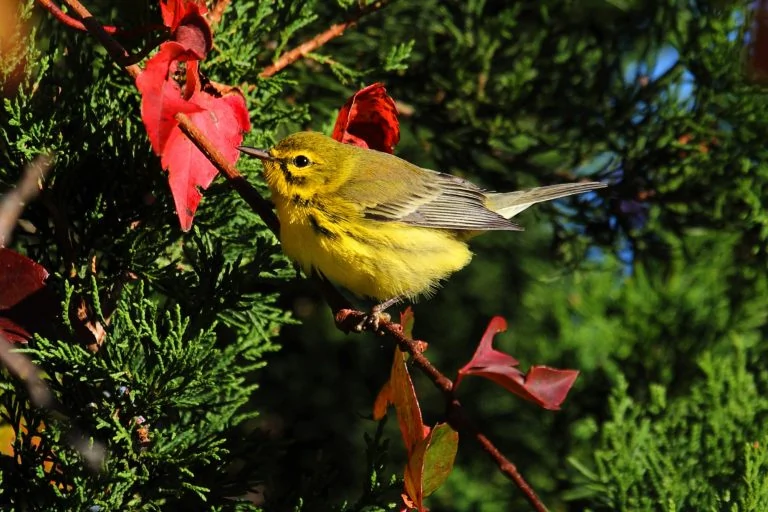
Prairie Warblers can be found in Indiana during the breeding season, from April to September, and appear in 6% of summer checklists.
Prairie Warblers are small songbirds with bright yellow plumage on their underparts and olive-green upperparts. They have black streaks on their sides and a distinctive black eye stripe.
Scientific name: Setophaga discolor
Length: 4.3-4.7 inches (11-12 cm)
Weight: 0.3-0.4 ounces (9-11 g)
Wingspan: 6.7-7.1 inches (17-18 cm)
Breeding populations of Prairie Warblers can be found in the eastern and central United States. They migrate to the Caribbean and Central America for the winter.
These warblers inhabit shrubby areas, old fields, and open woodlands, where they forage for insects and spiders.
Prairie Warbler Song:
Nests of Prairie Warblers are built close to the ground, often concealed in dense shrubs or low vegetation. They are cup-shaped structures made of grass, leaves, and plant fibers, lined with finer materials. They lay 3-6 eggs, which hatch after about 10-12 days. The young birds leave the nest within 9-12 days.
To attract Prairie Warblers to your backyard, provide dense shrubby habitats and maintain suitable open woodland areas.
Fun Fact: Prairie Warblers are known for their intricate courtship displays, where males perform acrobatic flights to impress females.
18. Hooded Warbler
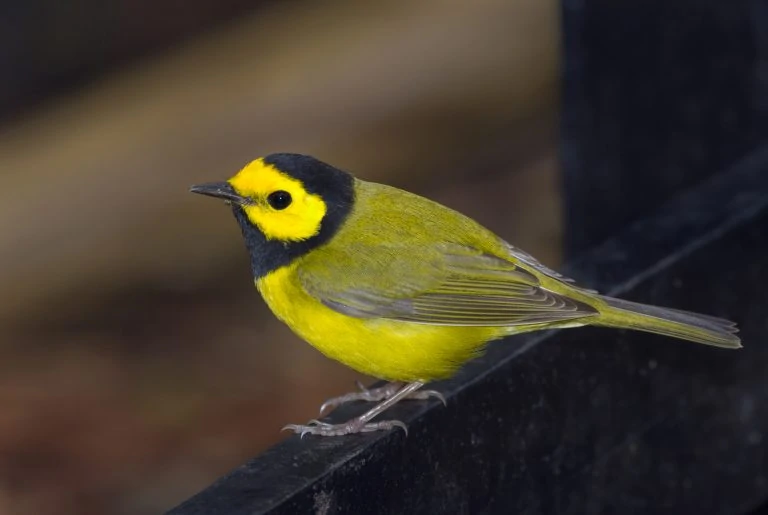
Hooded Warblers can be observed in Indiana during the breeding season, from April to September, and are recorded in 6% of summer checklists.
Hooded Warblers are small songbirds with bright yellow underparts and olive-green upperparts. Males have a distinctive black hood covering their head, while females have a duller olive coloration.
Scientific name: Setophaga citrina
Length: 4.3-5.1 inches (11-13 cm)
Weight: 0.3-0.4 ounces (9-11 g)
Wingspan: 6.3-7.1 inches (16-18 cm)
Breeding populations of Hooded Warblers can be found in the eastern United States and parts of the Midwest. They migrate to Mexico and Central America for the winter.
These warblers inhabit deciduous forests, woodland edges, and shrubby areas, where they forage for insects and spiders.
Hooded Warbler Song:
Nests of Hooded Warblers are built close to the ground, often concealed in dense vegetation. They are cup-shaped structures made of grass, leaves, and plant fibers, lined with finer materials. They lay 3-5 eggs, which hatch after about 12-14 days. The young birds leave the nest within 10-12 days.
To attract Hooded Warblers to your backyard, provide dense shrubby habitats, leaf litter, and maintain suitable woodland areas.
Fun Fact: Hooded Warblers are known for their unique foraging behavior, flipping over leaves to search for hidden insects.
19. Western Meadowlark
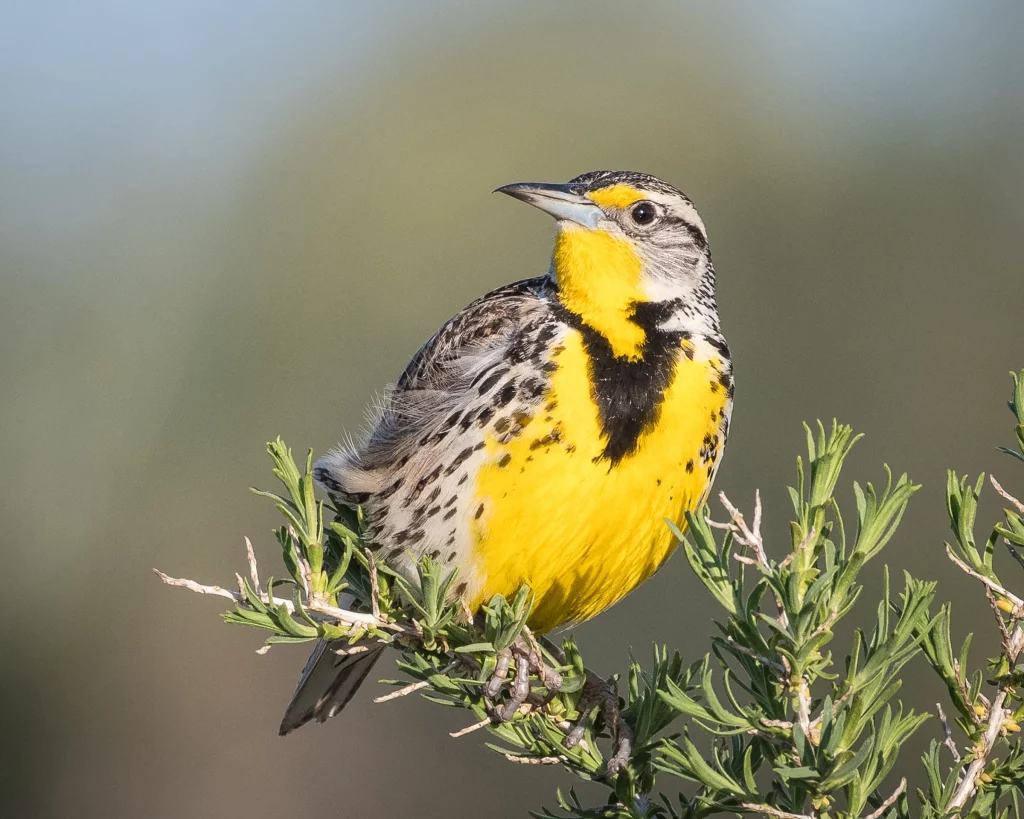
Western Meadowlarks can be spotted in Indiana during the breeding season, from April to September, and are recorded in 6% of summer checklists.
Western Meadowlarks have a yellow breast with a black V-shaped pattern, a brown back with black streaks, and a bright yellow face with a black “V” on the throat.
Scientific name: Sturnella neglecta
Length: 8.3-10.6 inches (21-27 cm)
Weight: 3.9-6.3 ounces (110-180 g)
Wingspan: 16.5-18.1 inches (42-46 cm)
Breeding populations of Western Meadowlarks can be found in the western and central United States. They migrate to southern United States and Mexico for the winter.
These meadowlarks inhabit grasslands, prairies, and agricultural fields, where they feed on insects, spiders, and seeds.
Western Meadowlark Song:
Nests of Western Meadowlarks are built on the ground, often hidden in tall grass or vegetation. They are cup-shaped structures made of grass and plant materials, lined with finer materials. They lay 3-7 eggs, which hatch after about 13-16 days. The young birds leave the nest within 10-12 days.
To attract Western Meadowlarks to your backyard, provide open grassy areas with a mixture of insects and seeds as food sources.
Fun Fact: Western Meadowlarks are known for their melodious and distinctive flute-like songs, which are often associated with open grasslands.
20. Yellow-headed Blackbird

Yellow-headed Blackbirds can be found in Indiana during the breeding season, from April to September, and appear in 6% of summer checklists.
Male Yellow-headed Blackbirds have a bright yellow head and breast, contrasting with their black bodies and wings. Females are duller overall, with streaked brown plumage.
Scientific name: Xanthocephalus xanthocephalus
Length: 9.1-10.6 inches (23-27 cm)
Weight: 2.8-3.9 ounces (80-110 g)
Wingspan: 14.2-16.5 inches (36-42 cm)
Breeding populations of Yellow-headed Blackbirds can be found in western
and central North America. They migrate to southwestern United States and Mexico for the winter.
These blackbirds inhabit marshes, wetlands, and open fields, where they forage for insects, seeds, and grains.
Yellow-headed Blackbird Call:
Nests of Yellow-headed Blackbirds are built in marshes, often attached to cattails or other emergent vegetation. They are woven structures made of marsh vegetation, lined with finer materials. They lay 3-5 eggs, which hatch after about 10-12 days. The young birds leave the nest within 11-14 days.
To attract Yellow-headed Blackbirds to your backyard, provide suitable wetland habitats and open areas with a variety of food sources.
Fun Fact: Yellow-headed Blackbirds are known for their highly gregarious behavior, often forming large colonies with other blackbirds and marsh-dwelling species.
21. Yellow-rumped Warbler

Yellow-rumped Warblers can be seen in Indiana during migration, particularly in April and May, and again in September and October. They are recorded in 5% of checklists during migration.
Yellow-rumped Warblers have a combination of yellow and gray plumage, with yellow on their throat, breast, and sides, and gray on their back and wings. They also have distinctive yellow patches on their rump.
Scientific name: Setophaga coronata
Length: 5.5-5.9 inches (14-15 cm)
Weight: 0.4-0.5 ounces (11-14 g)
Wingspan: 9.1-9.8 inches (23-25 cm)
Yellow-rumped Warblers breed in northern North America, including Canada and Alaska. They migrate to various parts of the United States, Mexico, and Central America for the winter.
During migration, they can be found in various habitats, including woodlands, parks, and gardens, where they forage for insects, berries, and fruits.
Yellow-rumped Warbler Song:
Nests of Yellow-rumped Warblers are built in coniferous trees, constructed with twigs, grass, and bark, lined with finer materials such as feathers and hair. They lay 4-5 eggs, which hatch after about 11-13 days. The young birds leave the nest within 10-12 days.
To attract Yellow-rumped Warblers to your backyard during migration, provide a mix of insects, suet, and berries.
Fun Fact: Yellow-rumped Warblers are known for their ability to digest wax from berries, allowing them to feed on fruits that other warbler species cannot.
22. Palm Warbler
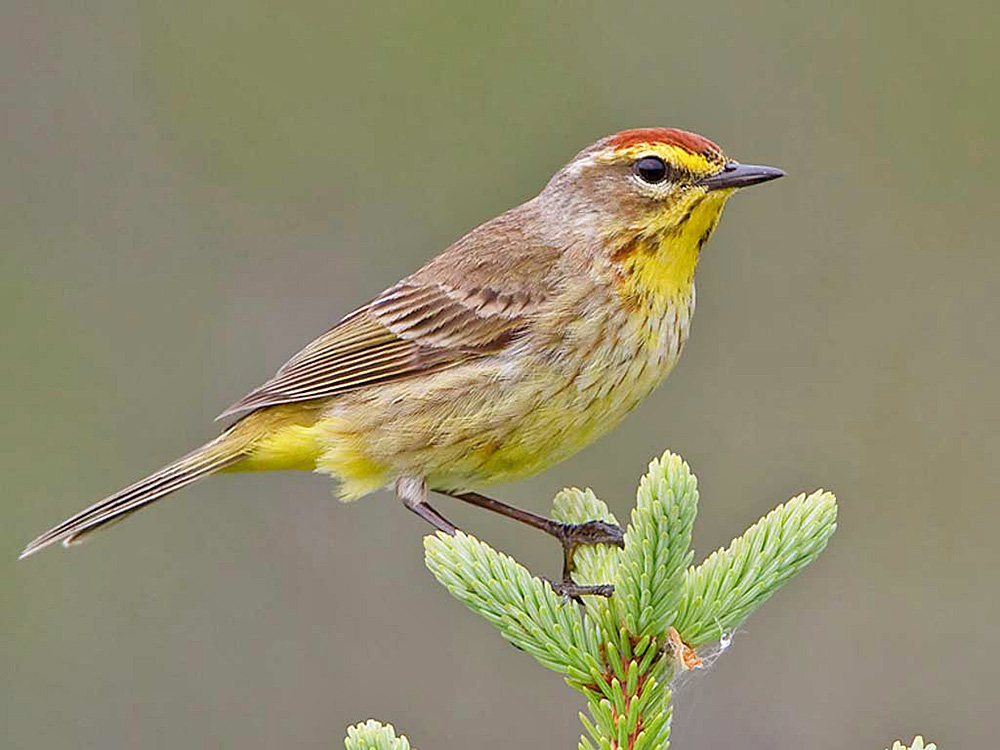
Palm Warblers pass through Indiana during migration, primarily in April and May, and again in September and October. They are recorded in 5% of checklists during migration.
Palm Warblers have a brownish-olive back, yellow underparts, and a rusty-colored cap on their heads. They also have a distinctive tail-wagging behavior.
Scientific name: Setophaga palmarum
Length: 4.7-5.1 inches (12-13 cm)
Weight: 0.3-0.4 ounces (9-11 g)
Wingspan: 7.9-8.3 inches (20-21 cm)
Palm Warblers breed in the boreal forests of Canada and Alaska. They migrate through the eastern United States and winter in the southeastern United States, Mexico, and the Caribbean.
During migration, they can be found in various habitats, including open woodlands, marshes, and grassy areas, where they forage for insects and berries.
Palm Warbler Song:
Nests of Palm Warblers are built on the ground in open areas, often hidden under vegetation or in grass tufts. They are cup-shaped structures made of grass, plant fibers, and moss, lined with finer materials. They lay 4-5 eggs, which hatch after about 12-13 days. The young birds leave the nest within 10-12 days.
To attract Palm Warblers to your backyard during migration, provide a mix of insects, berries, and a water source.
Fun Fact: Palm Warblers are known for their unique “tail-pumping” behavior, where they continuously flick their tails up and down while foraging on the ground.
23. Black-throated Green Warbler
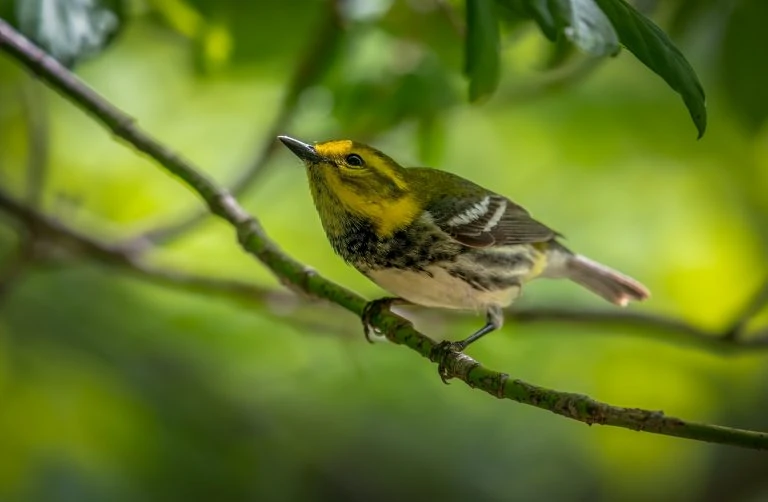
Black-throated Green Warblers pass through Indiana during migration, mainly in April and May, and again in September and October. They are recorded in 5% of checklists during migration.
Black-throated Green Warblers have olive-green upperparts, yellow underparts, and a distinctive black throat and face. Males have more extensive black markings than females.
Scientific name: Setophaga virens
Length: 4.7-5.1 inches (12-13 cm)
Weight: 0.3-0.4 ounces (9-11 g)
Wingspan: 7.5-8.3 inches (19-21 cm)
Black-throated Green Warblers breed in the northeastern United States and parts of Canada. They migrate through the eastern United States and winter in the Caribbean and Central America.
During migration, they can be found in various habitats, including deciduous and mixed forests, where they forage for insects.
Black-throated Green Warbler Song:
Nests of Black-throated Green Warblers are built in coniferous trees, constructed with twigs, moss, and lichens, lined with finer materials such as feathers and hair. They lay 3-5 eggs, which hatch after about 11-14 days. The young birds leave the nest within 9-12 days.
To attract Black-throated Green Warblers to your backyard during migration, provide a mix of insects and suitable vegetation for foraging.
Fun Fact: Black-throated Green Warblers have a unique “zee-zee-zee-zoo-zee” song that is often heard in their breeding territories.
24. Nashville Warbler
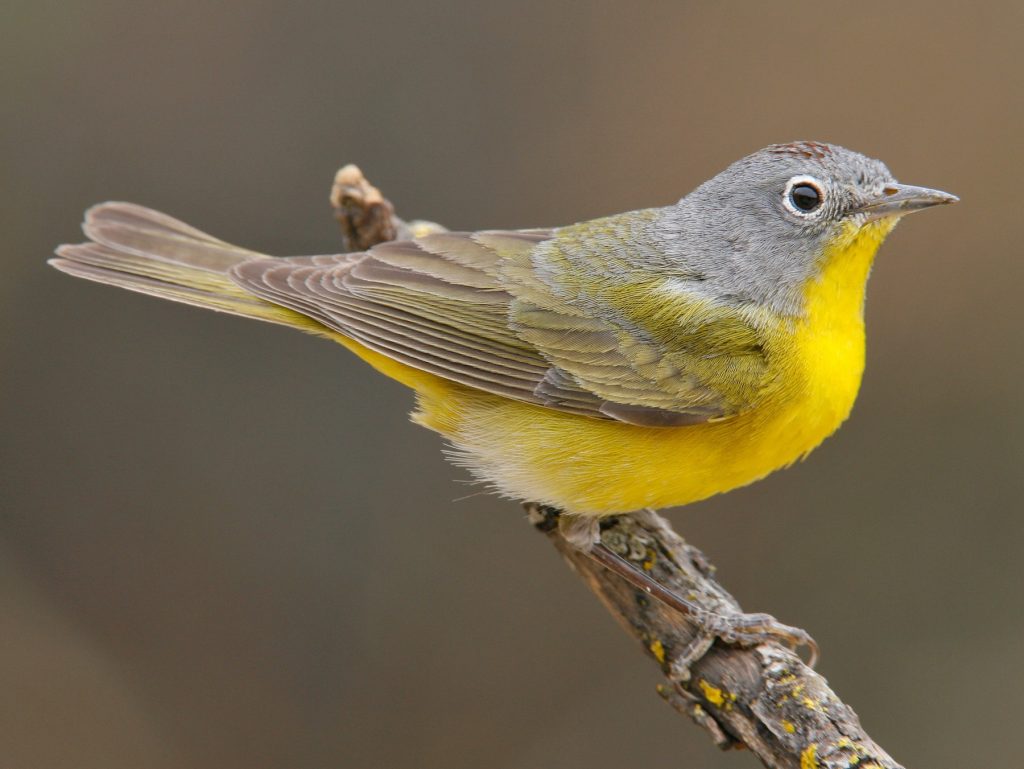
Nashville Warblers pass through Indiana during migration, primarily in April and May, and again in September and October. They are recorded in 5% of checklists during migration.
Nashville Warblers have olive-green upperparts, yellow underparts, and a distinctive gray head with a white eye ring. Males and females have similar plumage.
Scientific name: Leiothlypis ruficapilla
Length: 4.3-4.7 inches (11-12 cm)
Weight: 0.3-0.4 ounces (9-11 g)
Wingspan: 6.7-7.1 inches (17-18 cm)
Nashville Warblers breed in the northern United States and parts of Canada. They migrate through the central and eastern United States and winter in Mexico, Central America, and the Caribbean.
During migration, they can be found in various habitats, including deciduous forests, woodland edges, and shrubby areas, where they forage for insects.
Nashville Warbler Song:
Nests of Nashville Warblers are built close to the ground, often hidden in vegetation or on the ground. They are cup-shaped structures made of grass, plant fibers, and moss, lined with finer materials. They lay 3-5 eggs, which hatch after about 10-12 days. The young birds leave the nest within 9-12 days.
To attract Nashville Warblers to your backyard during migration, provide a mix of insects, suitable vegetation, and water sources.
Fun Fact: Nashville Warblers were named after their first recorded sighting in Nashville, Tennessee, during migration.
25. Magnolia Warbler
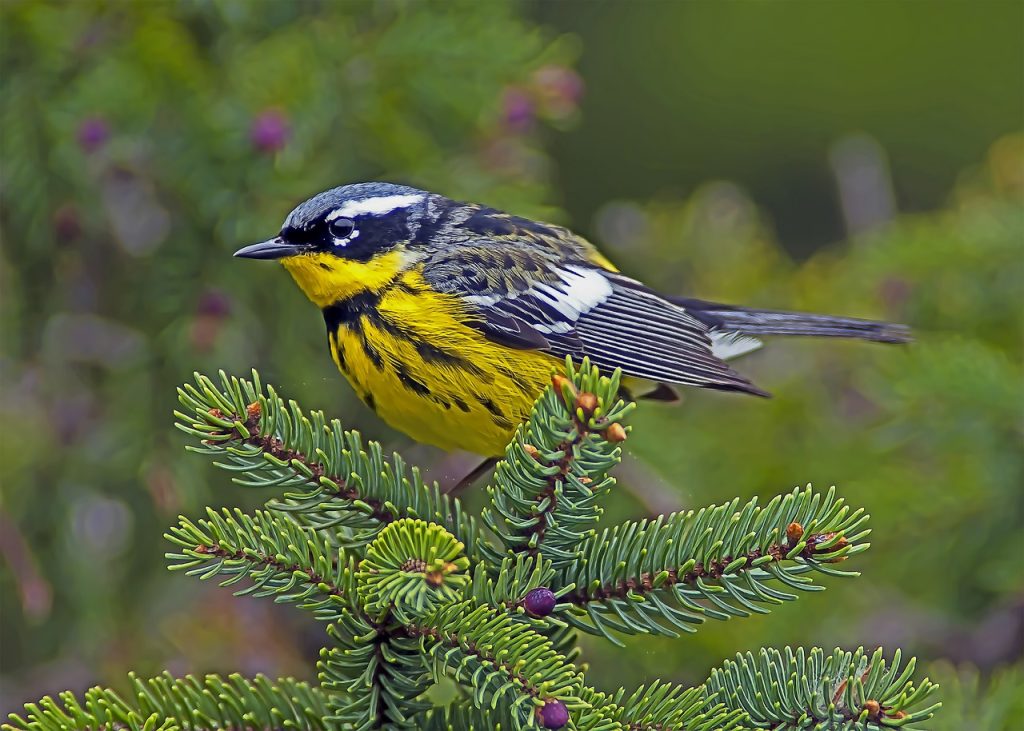
Magnolia Warblers pass through Indiana during migration, mainly in April and May, and again in September and October. They are recorded in 5% of checklists during migration.
Magnolia Warblers have black upperparts with white wing bars, a bright yellow throat and underparts, and a distinctive black necklace pattern on their breast.
Scientific name: Setophaga magnolia
Length: 4.3-5.1 inches (11-13 cm)
Weight: 0.3-0.4 ounces (9-11 g)
Wingspan: 7.1-8.3 inches (18-21 cm)
Magnolia Warblers breed in the boreal forests of Canada and Alaska. They migrate through the eastern United States and winter in Central America and the Caribbean.
During migration, they can be found in various habitats, including deciduous forests, woodlands, and shrubby areas, where they forage for insects.
Magnolia Warbler Song:
Nests of Magnolia Warblers are built in coniferous trees, constructed with twigs, grass, and bark, lined with finer materials. They lay 4-5 eggs, which hatch after about 10-12 days. The young birds leave the nest within 8-12 days.
To attract Magnolia Warblers to your backyard during migration, provide a mix of insects, suitable vegetation, and water sources.
Fun Fact: Magnolia Warblers were named after a magnolia tree, but they do not have any specific association with magnolia trees and can be found in a variety of habitats.
26. Blue-winged Warbler
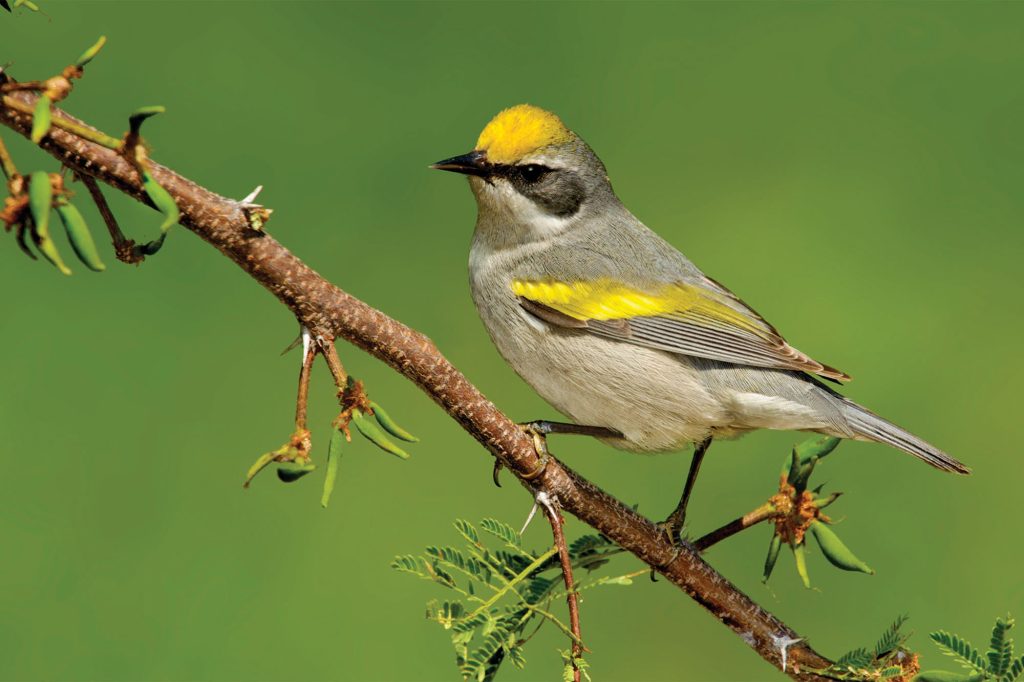
Blue-winged Warblers pass through Indiana during migration, primarily in April and May, and again in September and October. They are recorded in 5% of checklists during migration.
Blue-winged Warblers have yellow underparts, olive upperparts, and a distinctive blue-gray patch on their wings. Males and females have similar plumage.
Scientific name: Vermivora cyanoptera
Length: 4.7-5.1 inches (12-13 cm)
Weight: 0.3-0.4 ounces (9-11 g)
Wingspan: 7.5-8.3 inches (19-21 cm)
Blue-winged Warblers breed in the eastern and central United States, including parts of Indiana. They migrate through the southeastern United States and winter in Central America.
During migration, they can be found in various habitats, including shrubby areas, woodland edges, and second-growth forests, where they forage for insects.
Blue-winged Warbler Song:
Nests of Blue-winged Warblers are built close to the ground, often hidden in dense vegetation or shrubs. They are cup-shaped structures made of grass, plant fibers, and bark, lined with finer materials. They lay 4-6 eggs, which hatch after about 10-12 days. The young birds leave the nest within 8-10 days.
To attract Blue-winged Warblers to your backyard during migration, provide a mix of insects, suitable vegetation, and water sources.
Fun Fact: Blue-winged Warblers are known to hybridize with Golden-winged Warblers, resulting in a hybrid species known as the “Brewster’s Warbler” or “Lawrence’s Warbler.”
27. Pine Warbler
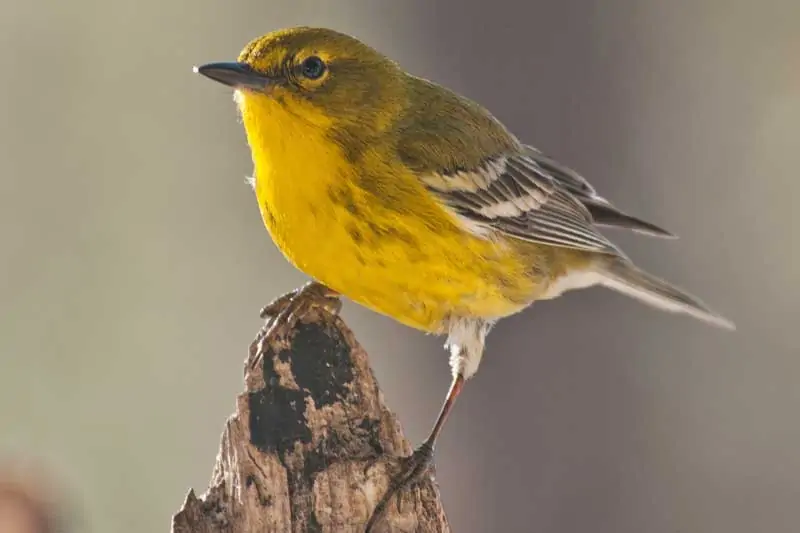
Pine Warblers pass through Indiana during migration, mainly in April and May, and again in September and October. They are recorded in 5% of checklists during migration.
Pine Warblers have olive-green upperparts, yellow underparts, and a streaked breast. They also have a distinctive white wing bar.
Scientific name: Setophaga pinus
Length: 4.7-5.9 inches (12-15 cm)
Weight: 0.3-0.4 ounces (9-11 g)
Wingspan: 7.5-9.1 inches (19-23 cm)
Pine Warblers breed in the eastern United States, including parts of Indiana. They migrate through the southeastern United States and winter in the southern United States and eastern Mexico.
During migration, they can be found in various habitats, including pine forests, mixed woodlands, and suburban areas, where they forage for insects and pine seeds.
Pine Warbler Song:
Nests of Pine Warblers are built high up in pine trees, constructed with twigs,
grass, and bark, lined with finer materials such as feathers and hair. They lay 3-5 eggs, which hatch after about 12-14 days. The young birds leave the nest within 10-12 days.
To attract Pine Warblers to your backyard during migration, provide a mix of insects, suitable vegetation, and pine trees.
Fun Fact: Pine Warblers are the only warbler species that regularly feed on pine seeds, using their thin beaks to extract the seeds from pine cones.
28. Cape May Warbler

Cape May Warblers pass through Indiana during migration, primarily in April and May, and again in September and October. They are recorded in 5% of checklists during migration.
Cape May Warblers have yellow underparts, greenish upperparts, and a distinctive rusty-colored patch on their cheeks and chest. Males and females have similar plumage.
Scientific name: Setophaga tigrina
Length: 4.3-5.1 inches (11-13 cm)
Weight: 0.3-0.4 ounces (9-11 g)
Wingspan: 7.5-8.3 inches (19-21 cm)
Cape May Warblers breed in the boreal forests of Canada and Alaska. They migrate through the eastern United States and winter in the Caribbean and Central America.
During migration, they can be found in various habitats, including woodlands, forest edges, and shrubby areas, where they forage for insects, especially those found in flowers.
Cape May Warbler Song:
Nests of Cape May Warblers are built high up in coniferous trees, constructed with twigs, grass, and bark, lined with finer materials. They lay 4-5 eggs, which hatch after about 11-13 days. The young birds leave the nest within 9-12 days.
To attract Cape May Warblers to your backyard during migration, provide a mix of insects, suitable vegetation, and water sources.
Fun Fact: Cape May Warblers have a unique feeding behavior where they extract nectar from flowers by piercing the base of the flower with their beak and inserting their tongue to suck the nectar.
29. Wilson’s Warbler

Wilson’s Warblers pass through Indiana during migration, mainly in April and May, and again in September and October. They are recorded in 5% of checklists during migration.
Wilson’s Warblers have bright yellow underparts, olive-green upperparts, and a distinctive black cap on their heads. Males and females have similar plumage.
Scientific name: Cardellina pusilla
Length: 4.3-4.7 inches (11-12 cm)
Weight: 0.3-0.4 ounces (9-11 g)
Wingspan: 6.7-7.1 inches (17-18 cm)
Wilson’s Warblers breed in the western United States and parts of Canada. They migrate through the western and central United States and winter in Mexico and Central America.
During migration, they can be found in various habitats, including woodlands, forest edges, and shrubby areas, where they forage for insects.
Wilson’s Warbler Song:
Nests of Wilson’s Warblers are built close to the ground, often hidden in vegetation or shrubs. They are cup-shaped structures made of grass, plant fibers, and bark, lined with finer materials. They lay 4-6 eggs, which hatch after about 10-12 days. The young birds leave the nest within 9-12 days.
To attract Wilson’s Warblers to your backyard during migration, provide a mix of insects, suitable vegetation, and water sources.
Fun Fact: Wilson’s Warblers are known for their active foraging
behavior, often hopping and flitting rapidly among foliage while searching for insects.
30. Mourning Warbler
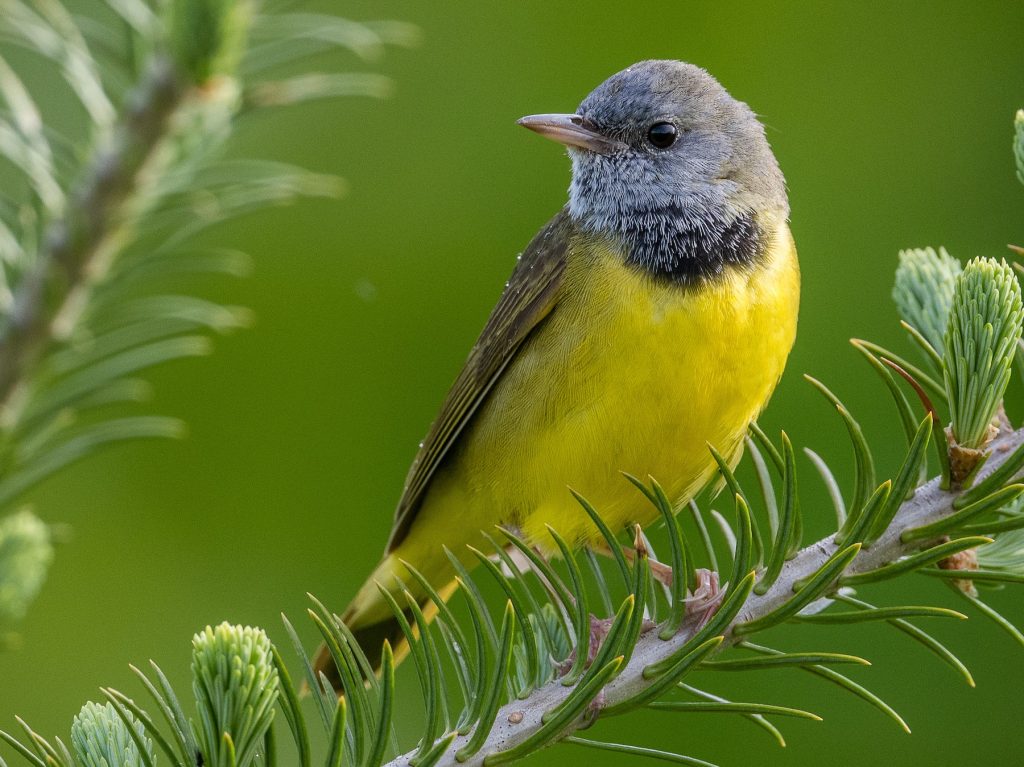
Mourning Warblers pass through Indiana during migration, primarily in April and May, and again in September and October. They are recorded in 5% of checklists during migration.
Mourning Warblers have grayish-olive upperparts, yellow underparts, and a distinctive black mask across their face. Males and females have similar plumage.
Scientific name: Geothlypis philadelphia
Length: 4.3-5.1 inches (11-13 cm)
Weight: 0.3-0.4 ounces (9-11 g)
Wingspan: 7.1-8.3 inches (18-21 cm)
Mourning Warblers breed in the northeastern United States and parts of Canada. They migrate through the eastern United States and winter in Central America and the Caribbean.
During migration, they can be found in various habitats, including wet thickets, shrubby areas, and forest edges, where they forage for insects.
Mourning Warbler Song:
Nests of Mourning Warblers are built on or near the ground, often hidden in dense vegetation or low shrubs. They are cup-shaped structures made of grass, plant fibers, and bark, lined with finer materials. They lay 4-5 eggs, which hatch after about 12-13 days. The young birds leave the nest within 9-12 days.
To attract Mourning Warblers to your backyard during migration, provide a mix of insects, suitable vegetation, and water sources.
Fun Fact: Mourning Warblers are named for their melancholic-sounding song, which is often described as a series of low, mournful notes.
31. Connecticut Warbler
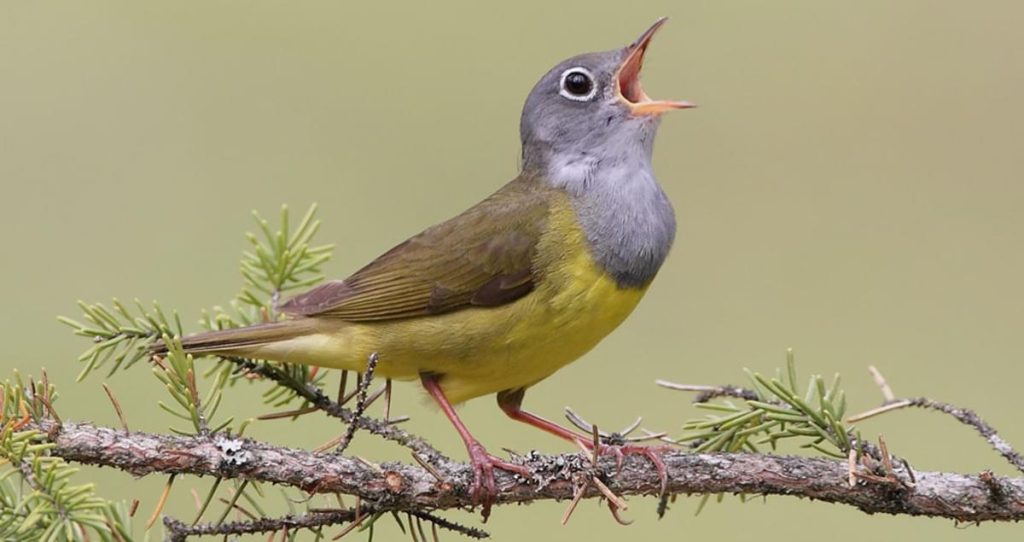
Connecticut Warblers pass through Indiana during migration, mainly in May and September. They are recorded in less than 5% of checklists during migration, making them less common to spot.
Connecticut Warblers have olive-brown upperparts, yellow underparts, and a grayish head with a distinctive yellow eyering. Males and females have similar plumage.
Scientific name: Oporornis agilis
Length: 5.5-5.9 inches (14-15 cm)
Weight: 0.4-0.5 ounces (11-14 g)
Wingspan: 9.1-9.8 inches (23-25 cm)
Connecticut Warblers breed in the boreal forests of Canada and Alaska. They migrate through the central United States and winter in northern South America.
During migration, they can be found in various habitats, including moist woodlands, thickets, and shrubby areas, where they forage for insects.
Connecticut Warbler Song:
Nests of Connecticut Warblers are built on or near the ground, often hidden in dense vegetation or low shrubs. They are cup-shaped structures made of grass, plant fibers, and bark, lined with finer materials. They lay 4-5 eggs, which hatch after about 12-13 days. The young birds leave the nest within 9-12 days.
To attract Connecticut Warblers to your backyard during migration, provide a mix of insects, suitable vegetation, and water sources.
Fun Fact: Despite its name, the Connecticut Warbler has no known connection to the state of Connecticut and was named after a misidentified specimen.
